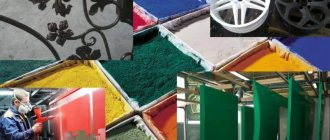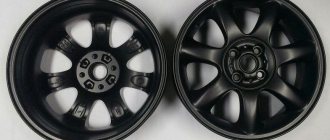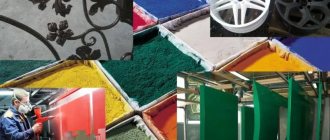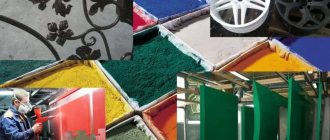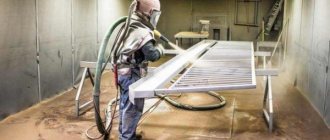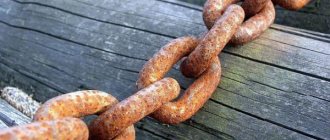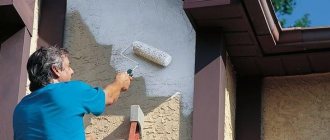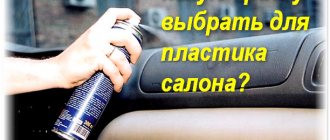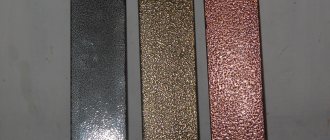Reading time: ~ 10 minutes A huge variety of color palettes, resistance to mechanical stress and fading, and high quality paint coatings have led to the widespread use of powder paints. At the same time, despite the availability of information, users have many questions about the choice and features of using this type of paint and varnish materials. In particular, we are often asked how to dilute powder paint . Below we will answer in detail what, as well as other important and pressing questions.
Types of powder paints
Powder paint is a material with colored pigment in powder form. It protects the metal surface from moisture and prevents rust. Durability, additional strength and even electrical insulation are its features.
In addition to the pigment, the composition also includes other substances: resins form a film, and catalysts are responsible for hardening. Powder coating is common in construction, automotive and interior design. This way you can achieve a matte or glossy, voluminous or flat surface.
Paint is divided into 2 types:
- Thermoplastic. The decisive factor here is high temperature. Resins are added to the composition: vinyls, nylons or polyester. After heating, they form a hard coating preserving the composition and structure of the original raw material. This powder coating allows the metal object to be reheated and the layers re-formed.
- Thermosetting. Film formation occurs as a result of a chemical reaction. Acrylic, epoxy or polyester resins are used to produce paints.
You can paint objects of any size and even with a complex design Source rzsd62.ru
Thermoactive colors are suitable for products that are used in harsh climatic conditions. Once applied, the powder coating reforms and does not deform when reheated.
The components in the composition are safe. They have a high degree of flowability, which is why they do not stick to objects and skin. The shelf life is unlimited, the color does not fade, and the consistency does not thicken over time. Properties are preserved until the moment of use. No solvent needed.
See also: Catalog of companies that specialize in paints and varnishes and related work
Method of using the remover
The structure of the solvent (removal) is viscous. After covering the exterior, a softening of the powder color occurs.
After this, you need to use a special tool to remove the paint. Moreover, it must be used immediately, since the paint may dry out and the procedure must be repeated again.
To use the product, no actions related to diluting it are necessary. All you have to do is read the instructions and get started.
Dyeing technology
When powder painting, painting technology is of great importance. The idea is to spray dry particles onto a degreased and cleaned surface. Positively charged paint particles easily stick to a negatively charged metal surface. This creates an even and uniform layer.
Only two spraying methods are used:
- Electrostatic . Electrostatically charged powder is applied to the grounded surface. This is done using a powder coating gun. Kohler acquires an electrical charge due to ionized air. It is located in the corona discharge area and is formed between the electrodes of the charging tip and the surface to be painted.
Electrostatic Painting Source graco.com
A high voltage source is built into the sprayer design. The main disadvantage of this method is the inability to apply paint into small depressions and recesses.
- Tribostatic . This method uses compressed air. As a result of friction with the dielectric, a charge appears. It holds paint molecules on the surface being painted. The dielectric is fluoroplastic - the atomizer is made from this material. This method is used for painting products with complex geometry. It is possible to use multi-jet nozzles, which increase the accuracy and uniformity of paint application.
Features of removal from different surfaces
Powder paints have increased adhesive characteristics; only special removers can be used to remove them. Solvents (white spirit, turpentine) will not cope with the task. When choosing a preparation, the type of material from which the color is removed is also taken into account.
Aluminum
To remove paint from aluminum (in particular, from car wheels), it is convenient to use removers. The paint layer is removed by applying gel-like products or by immersing the part in a container with the preparation. The following tools are suitable:
- "Fail-2", "Fail-4";
- Docker S;
- "Remover".
See also
Do-it-yourself technology for painting crushed stone for decoration at home
These preparations wash off powder dyes with different bases:
- polyester;
- polyurethane;
- epoxy;
- epoxy polyester;
- polyacrylate.
For aluminum surfaces, you can use other types of paint removal - water- and sandblasting, firing.
Metal
To remove paint from metal surfaces, removers (gels and liquids), sandblasting and waterjet methods are used. Chemical solvents (washes) contain special corrosion inhibitors and remove pockets of rust from products and surfaces. Most popular removers are suitable for metal.
Note that the firing method is not used for cast iron and brass. Do not use the thermal method for sheet and galvanized iron. The sheets become deformed and scale appears on them. The products will require sanding in the future.
Small metal products can be immersed in a container with a remover; for vertical surfaces it is convenient to use a gel.
Stages of work
Powder coating technology consists of three stages of work: surface preparation, painting and polymerization.
Surface preparation
It includes: cleaning from contaminants, degreasing, phosphating.
Dirt, rust and oxides are removed from the surface of a metal product. If you skip the cleaning step, the paint will peel off and you will have to redo it. The best cleaning method is shot blasting. Small granules are directed to the surface under pressure or using centrifugal force. Cast iron or steel granules, as well as sand, are used as granules.
On what surfaces can it be used?
Powerful adhesion makes powder coating ideal for stainless steels. In general, when processing metal products for household, industrial and transport purposes, powder is used much more often than liquid compounds. This is exactly how the components of warehouse and sales equipment, machine tools, metal pipelines and wells are painted. In addition to the ease of application, the attention of engineers to this method of processing is attracted by the safety of the paint in fire and sanitary terms, and its zero level of toxicity.
Forged structures, aluminum and stainless steel products can easily be powder painted. This coating method is also used in the production of laboratory, medical equipment, and sports equipment.
Products made of ferrous metals, including those with an outer zinc layer, ceramics, MDF, and plastic can also be a good substrate for powder coating.
Dyes based on polyvinyl butyral are distinguished by increased decorative properties, are resistant to gasoline, do not conduct electric current, and tolerate contact with abrasive substances well. The ability to survive the ingress of water, even salty water, is very useful when creating pipelines, heating radiators, and other communications in contact with liquid.
When applying a special powder to the surface of an aluminum profile, the priority is not so much protection against corrosion, but rather giving it a beautiful appearance. It is imperative to select the operating mode, depending on the composition of the dye and the characteristics of the substrate, and take into account the specifics of the equipment. An aluminum profile with a thermal insert is processed for at most 20 minutes when heated to no higher than 200 degrees. The electrostatic method is worse than the tribostatic method when painting metal products with blind holes.
The use of fluorescent powder paint is practiced when working on road signs and other information structures, when glow in the dark is more important. For the most part, aerosol formulations are used as they are the most practical and create the most even layer.
Video description
This video shows how to clean rust from metal.
Chemical cleaning or etching is suitable for degreasing the surface before powder coating of metal products. Sulfuric, nitric or phosphoric acids are used as a reagent. Phosphating is similar to priming. When treated with a special composition, a phosphate film is formed, which improves adhesion.
Coloring
For these purposes, a special room is equipped - a chamber - with a forced air suction system. Large-sized products are painted in walk-through type chambers, and small parts are painted in dead-end type chambers. A special gun sprays the color. The step-by-step process looks like this:
- Powder paint is poured into a special hopper and mixed there with air. The proportions are adjusted using valves.
- A mixture of paint and air passes through a spray gun with a high-voltage source, acquiring a positive charge.
- The process of spraying paint onto the product occurs.
- The last step is extraction to remove loose particles. Entering a special bunker, they are again sent through the painting cycle.
Safety when removing powder coatings
Since the wash contains active synthetic additives, you will need special personal protective equipment for the body - eyes, hands, body skin.
It is better to use a solvent on an open surface, since chemical components can negatively affect the health of the master.
If indoor use is unavoidable, you must first ensure that it is well ventilated.
Video description
This video shows the consequences of underbaking and overbaking paint.
The process of paint polymerization occurs. It takes 15-30 minutes to complete the full cycle. Microparticles of powder paint are melted, forming a film, then hardened and cooled. The time for this stage depends on the size of the part, the type of oven and the type of paint.
The temperature required for the process is kept in the range of 150-200 °C. After which the molten powder fills all small irregularities, this guarantees tight contact between the paint and the surface.
Then the part is cooled. The coating becomes durable, and the product receives protection from adverse environmental influences.
Consumption
The attractiveness of powder paint is beyond doubt. However, you need to accurately determine the need for it, find out how much coloring composition is used for each m2. The minimum thickness of the created layer is 100 microns, to reduce the use of dye, it is advisable to spray it. The aerosol method of application allows you to spend from 0.12 to 0.14 kg of material per 1 square meter. But all these calculations are only approximate and allow us to determine the order of the numbers.
An accurate assessment can be made by knowing the properties of a particular type of paint and the characteristics of the substrate on which it will be applied. Remember that the standard indicated on labels and packaging, displayed on advertising posters, implies painting a surface that is absolutely free of pores. Plastic or metal has only slight porosity, and therefore even when painting them, you will need to use a little more dye than prescribed by the manufacturer. When other materials need to be processed, costs will increase significantly. So don’t be indignant when you find “inflated” numbers in your bills for powder painting services.
There are decorative, protective and combined coatings; depending on the specific group they belong to, a layer of varying thickness is formed. You also need to take into account the geometric shape of the surface and the difficulties of working with it.
Video description
This video shows the powder coating process
- To spray powder materials, use the minimum required amount of air. When oversaturation occurs, there is an increase in color consumption, increased load on the equipment, disruption of the electrification process, changes in the granules of the powder material, plus, visibility in the spray booth noticeably deteriorates.
- Use air of the best quality, without impurities.
- Carefully homogenize the powder mixture before use.
- Do not mix different colors. Before using a new color, thoroughly clean the equipment.
- Pay great attention to surface preparation before painting.
- Storage conditions for powder paints must be observed to avoid deterioration of the raw materials, which will affect the final result.
- The technological process must be followed in detail at all stages of painting work.
- Monitoring, prevention and maintenance of units is a necessity.
- Correctly configured production cycles guarantee a reduction in the loss of coloring pigment to 2% -5%.
Rules and recommendations will help achieve uniformity and elasticity of the coating, as well as a long service life.
Sandblasting method of disposal
A sandblaster removes powder paint from surfaces using the pressure of water mixed with sand. Sandblasting is an expensive type of equipment; experience and knowledge are required to operate the unit.
The area of impact of the jet is small (10-12 square centimeters), so cleaning a large surface will require a lot of time and effort. The nozzles of the device are adjustable; sandblasting can be used to remove paint from objects of complex configuration. The pressure of the jet removes pockets of rust and creates slight roughness, which will enhance adhesion during new painting.
Briefly about the main thing
Powder paint is a modern type of painting materials for metal. The scope of application ranges from painting small household appliances and interior items to metal structures.
There are two main types of powder paints - thermoplastic and thermosetting. The choice of method depends on the tasks at hand. There are also only two types of dyeing technologies - electrostatic and tribostatic. In the first case, a powerful high voltage source is used, in the second it is absent.
Painting is done in 3 stages: first, prepare the surface - clean it of dirt, dust and old layers of paint. Products are painted using an air suction system. The final stage is polymerization. The painted object is sent to the oven to fix the paint, followed by the processes of hardening and cooling.
Ratings 0
